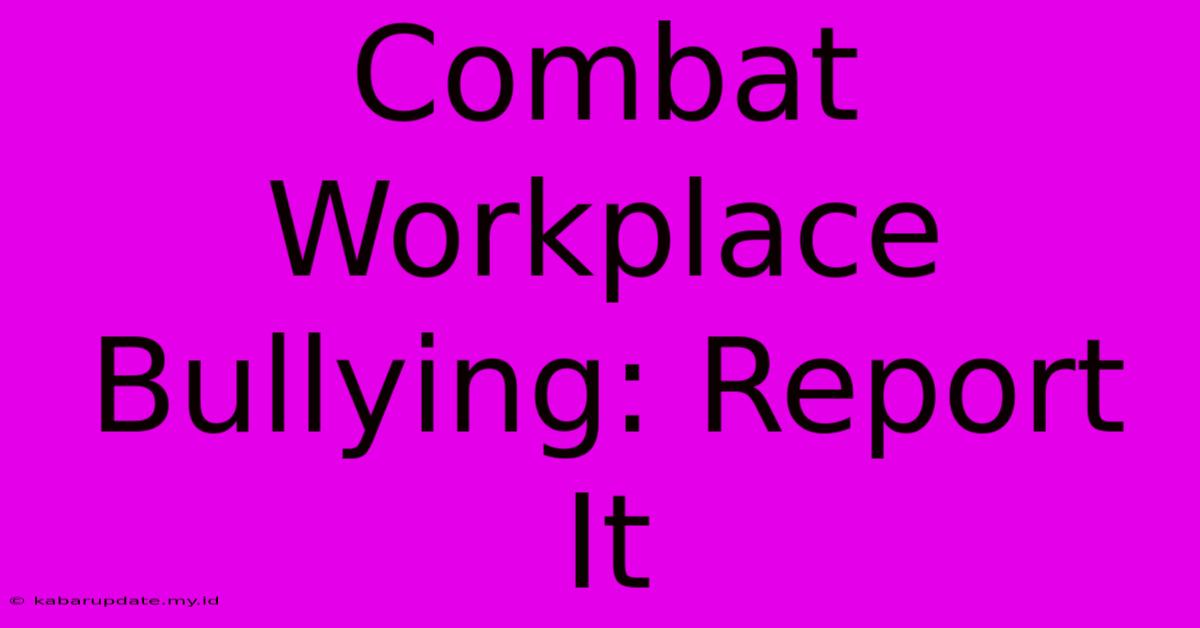Combat Workplace Bullying: Report It

Discover more detailed and exciting information on our website. Click the link below to start your adventure: Visit Best Website meltwatermedia.ca. Don't miss out!
Table of Contents
Combat Workplace Bullying: Report It
Workplace bullying is a serious issue that can have devastating consequences for victims. It's not just "a bit of teasing" or "tough love"—it's a pattern of harmful behaviors that can severely impact mental health, productivity, and overall well-being. If you're experiencing bullying, reporting it is crucial. This article will guide you through understanding why reporting is important, how to do it effectively, and what support systems are available.
Understanding the Importance of Reporting Workplace Bullying
Many victims hesitate to report bullying, fearing retaliation, being dismissed, or not being believed. However, remaining silent only allows the bullying to continue, potentially harming not only you but also other colleagues. Reporting is essential for several reasons:
- Protection: Reporting creates a documented record of the incidents, providing crucial evidence to protect you from further harm.
- Prevention: Reporting can help prevent the bully from targeting other employees.
- Resolution: Formal reporting processes often lead to investigations and potential disciplinary actions against the bully.
- Support: Reporting allows you access to support systems, including HR, employee assistance programs (EAPs), and legal counsel.
- Validation: Reporting validates your experience and allows you to reclaim your power in the situation.
How to Effectively Report Workplace Bullying
Reporting workplace bullying requires careful planning and documentation. Here's a step-by-step guide:
1. Document Everything
Keep a detailed record of every incident, including:
- Date and time: When did the incident occur?
- Location: Where did the incident take place?
- Description of the incident: Describe the event in detail, using specific and factual language. Avoid emotional language, focusing on observable behaviors.
- Witnesses: Note the names of any witnesses who observed the incident.
- Impact: Describe how the incident affected you (e.g., stress, anxiety, loss of sleep).
2. Choose the Right Reporting Channel
Most workplaces have established procedures for reporting harassment and bullying. Common channels include:
- Human Resources (HR): HR is often the first point of contact for reporting workplace issues.
- Supervisor or Manager: If you feel comfortable, you can report the bullying to your immediate supervisor or manager.
- Internal Complaint System: Some organizations have specific internal complaint systems designed to handle such matters.
- Union Representative: If you're part of a union, your union representative can provide support and guidance.
3. Be Prepared
Before reporting, consider:
- What you want to achieve: What outcome are you hoping for? (e.g., cessation of bullying, an apology, disciplinary action).
- Your support system: Do you have friends, family, or a therapist who can offer support?
4. Formal Reporting
During the formal reporting process, be clear, concise, and factual. Provide your documented evidence. Remain calm and professional.
Support Systems Available to Victims of Workplace Bullying
You are not alone. Many resources can help you cope with and report workplace bullying:
- Human Resources (HR) Department: Your company's HR department is responsible for investigating complaints and ensuring a safe work environment.
- Employee Assistance Programs (EAPs): Many companies offer EAPs, which provide confidential counseling and support services.
- Legal Counsel: If the bullying is severe or the company fails to take appropriate action, you may wish to consult with an employment lawyer.
- Support Groups: Connecting with others who have experienced workplace bullying can be incredibly helpful.
Remember: Reporting workplace bullying is a brave step. While it may feel daunting, it's a crucial step towards creating a healthier and safer work environment for yourself and others. Don't suffer in silence. Take action and report the bullying. You deserve a workplace free from harassment and intimidation.

Thank you for visiting our website wich cover about Combat Workplace Bullying: Report It. We hope the information provided has been useful to you. Feel free to contact us if you have any questions or need further assistance. See you next time and dont miss to bookmark.
Featured Posts
-
A Draw Guardiola Sees A Loss
Nov 27, 2024
-
Buriram United Vs Kawasaki Free Live Stream
Nov 27, 2024
-
Bayern Wins Psg Loses Champions League
Nov 27, 2024
-
Self Belief Commitment Guardiolas View
Nov 27, 2024
-
Watch Free Buriram Vs Kawasaki Frontale 2024
Nov 27, 2024
